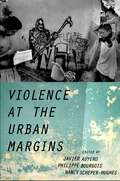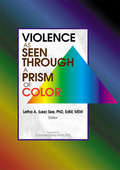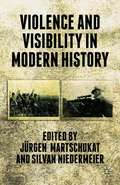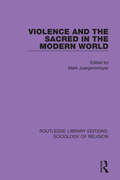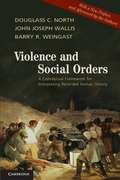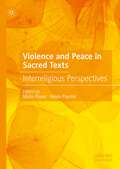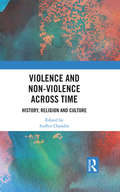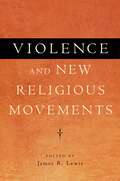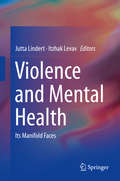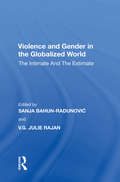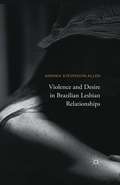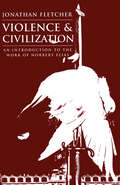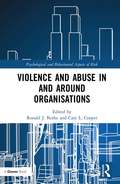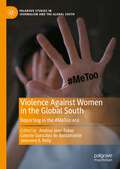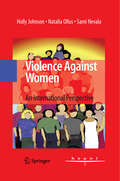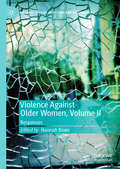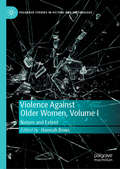- Table View
- List View
Violence at the Urban Margins (Global and Comparative Ethnography)
by Javier Auyero Philippe Bourgois Nancy Scheper-HughesIn the Americas, debates around issues of citizen's public safety--from debates that erupt after highly publicized events, such as the shootings of Jordan Davis and Trayvon Martin, to those that recurrently dominate the airwaves in Latin America--are dominated by members of the middle and upper-middle classes. However, a cursory count of the victims of urban violence in the Americas reveals that the people suffering the most from violence live, and die, at the lowest of the socio-symbolic order, at the margins of urban societies. The inhabitants of the urban margins are hardly ever heard in discussions about public safety. They live in danger but the discourse about violence and risk belongs to, is manufactured and manipulated by, others--others who are prone to view violence at the urban margins as evidence of a cultural, or racial, defect, rather than question violence's relationship to economic and political marginalization. As a result, the experience of interpersonal violence among the urban poor becomes something unspeakable, and the everyday fear and trauma lived in relegated territories is constantly muted and denied. This edited volume seeks to counteract this pernicious tendency by putting under the ethnographic microscope--and making public--the way in which violence is lived and acted upon in the urban peripheries. It features cutting-edge ethnographic research on the role of violence in the lives of the urban poor in South, Central, and North America, and sheds light on the suffering that violence produces and perpetuates, as well as the individual and collective responses that violence generates, among those living at the urban margins of the Americas.
Violence as Seen Through a Prism of Color
by Letha A SeeSo many parts of society target citizens of color for violence--what can be done? Violence as Seen Through a Prism of Color examines violence from a structural perspective, including violence in prisons, schools and colleges, churches, homes, and within political/corporate structures.This unique, hard-hitting book argues that individual violence stems from the structure of our society and its institutions. Most of the contributors are African- American educators and practitioners who have a thorough understanding of structural violence. Some have experienced political violence; others have expert knowledge of structural violence within the criminal justice system, educational institutions, and elsewhere--even in churches and homes. Their writings are undeniably, unflinchingly authentic--it is impossible not to be moved and enraged by what they have to say. The good news is that in addition to calling attention to the structural violence in our society they provide excellent insights on how the situation might be resolved.Violence as Seen Through a Prism of Color shows: that much of the violence within the criminal justice system stems from decisions made at the highest levels of government that minority offenders are much more frequently convicted and more harshly sentenced than their white counterparts how cultural racism contributes to the construction of motives for lynching, hate crime, and police violence against Americans of color such as Abner Louima, Amadou Diallo, and Rodney King how the judicial system encourages black on black violence by neglecting to halt criminal activities in non-white neighborhoods how, in the words of Mahatma Gandhi, ”Poverty is the worst form of violence”You’ll also learn: how corporations are amassing great wealth through privatizing prisons and conscripting the labor of non-violent African-American prisoners how racial profiling affects people of color how the media has exploited black men imprisoned for minor drug offenses how and why violence occurs in and against the black churchHelpful charts and tables (like one that names the corporations that use prison labor) supplement the material--you’ll be surprised at what you learn! Extensive references are included at the end of each chapter.
Violence as Seen Through a Prism of Color
by Letha A SeeSo many parts of society target citizens of color for violence--what can be done? Violence as Seen Through a Prism of Color examines violence from a structural perspective, including violence in prisons, schools and colleges, churches, homes, and within political/corporate structures.This unique, hard-hitting book argues that individual violence stems from the structure of our society and its institutions. Most of the contributors are African- American educators and practitioners who have a thorough understanding of structural violence. Some have experienced political violence; others have expert knowledge of structural violence within the criminal justice system, educational institutions, and elsewhere--even in churches and homes. Their writings are undeniably, unflinchingly authentic--it is impossible not to be moved and enraged by what they have to say. The good news is that in addition to calling attention to the structural violence in our society they provide excellent insights on how the situation might be resolved.Violence as Seen Through a Prism of Color shows: that much of the violence within the criminal justice system stems from decisions made at the highest levels of government that minority offenders are much more frequently convicted and more harshly sentenced than their white counterparts how cultural racism contributes to the construction of motives for lynching, hate crime, and police violence against Americans of color such as Abner Louima, Amadou Diallo, and Rodney King how the judicial system encourages black on black violence by neglecting to halt criminal activities in non-white neighborhoods how, in the words of Mahatma Gandhi, ”Poverty is the worst form of violence”You’ll also learn: how corporations are amassing great wealth through privatizing prisons and conscripting the labor of non-violent African-American prisoners how racial profiling affects people of color how the media has exploited black men imprisoned for minor drug offenses how and why violence occurs in and against the black churchHelpful charts and tables (like one that names the corporations that use prison labor) supplement the material--you’ll be surprised at what you learn! Extensive references are included at the end of each chapter.
Violence and Visibility in Modern History
by JüRGEN Martschukat Silvan NiedermeierDespite the claims of Steven Pinker and others, violence has remained a historical constant since the Enlightenment, even though its forms and visibility have been radically transformed. Accordingly, the studies gathered here recast debate over violence in modern societies by undermining teleological and reassuring narratives of progress.
Violence and the Sacred in the Modern World (Routledge Library Editions: Sociology of Religion #17)
by Mark JuergensmeyerHow is symbolic violence related to the real acts of religious violence around the modern world? The authors of this book, first published in 1992, explore this question with reference to some of the most volatile religious and political conflicts of the day: Hezbollah in Lebanon, Sikhs in India, militant Jewish groups in Israel, and Muslim movements from the Middle East to Indonesia. In addition to providing valuable insights into these important incidents, the authors – social scientists and historians of comparative religion – are responding to the theoretical issues articulated by René Girard in Violence and the Sacred (1977). The present volume is the first book of essays to test Girard’s theories about the social significance of religious symbols of violence against real, rather than symbolic, acts. In some cases his theories are found to be applicable; in other cases, the authors provide alternative theories of their own. In a concluding essay, co-authored by Mark Anspach, Girard provides a response.
Violence and the Sacred in the Modern World (Routledge Library Editions: Sociology of Religion #17)
by Mark JuergensmeyerHow is symbolic violence related to the real acts of religious violence around the modern world? The authors of this book, first published in 1992, explore this question with reference to some of the most volatile religious and political conflicts of the day: Hezbollah in Lebanon, Sikhs in India, militant Jewish groups in Israel, and Muslim movements from the Middle East to Indonesia. In addition to providing valuable insights into these important incidents, the authors – social scientists and historians of comparative religion – are responding to the theoretical issues articulated by René Girard in Violence and the Sacred (1977). The present volume is the first book of essays to test Girard’s theories about the social significance of religious symbols of violence against real, rather than symbolic, acts. In some cases his theories are found to be applicable; in other cases, the authors provide alternative theories of their own. In a concluding essay, co-authored by Mark Anspach, Girard provides a response.
Violence And Social Orders (PDF)
by Douglass C. North John Joseph Wallis Barry R. WeingastAll societies must deal with the possibility of violence, and they do so in different ways. This book integrates the problem of violence into a larger social science and historical framework, showing how economic and political behavior are closely linked. Most societies, which we call natural states, limit violence by political manipulation of the economy to create privileged interests. These privileges limit the use of violence by powerful individuals, but doing so hinders both economic and political development. In contrast, modern societies create open access to economic and political organizations, fostering political and economic competition. The book provides a framework for understanding the two types of social orders, why open access societies are both politically and economically more developed, and how some 25 countries have made the transition between the two types.
Violence and Peace in Sacred Texts: Interreligious Perspectives
by Maria Power Helen PaynterThis volume brings together 11 experts from a range of religious backgrounds, to consider how each tradition has interpreted matters of violence and peace in relation to its sacred text. The traditions covered are Hinduism, Buddhism, Judaism, Christianity, Islam and Sikhism. The role of religion in conflict, war, and the creation of peaceful settlements has attracted much academic attention, including considerations of the interpretation of violence in sacred texts. This collection breaks new ground by bringing multiple faiths into conversation with one another with specific regard to the handling of violence and peace in sacred texts. This combination of close attention to text and expansive scope of religious inclusion is the first of its kind.
Violence and Non-Violence across Time: History, Religion and Culture
by Sudhir ChandraThis book probes the complex interweaving, across time and cultures, of violence and non-violence from the perspective of the present. One of the first of its kind, it offers a comprehensive examination of the interpenetration of violence and non-violence as much in human nature as in human institutions with reference to different continents, cultures and religions over centuries. It points to the present paradox that even as violence of unprecedented lethality threatens the very survival of humankind, non-violence increasingly appears as an unlikely feasible alternative. The essays presented here cover a wide cultural–temporal spectrum — from Vedic sacrifice, early Jewish–Christian polemics, the Crusades, and medieval Japan to contemporary times. They explore aspects of the violence–non-violence dialectic in a coherent frame of analysis across themes such as war, jihad, death, salvation, religious and philosophical traditions including Buddhism, Christianity, Judaism, Hinduism, Islam, mysticism, monism, and Neoplatonism, texts such as Ramayana, Mahabharata and Quran, as well as issues faced by Dalits and ethical imperatives for clinical trials, among others. Offering thematic width and analytical depth to the treatment of the subject, the contributors bring their disciplinary expertise and cultural insights, ranging from the historical to sociological, theological, philosophical and metaphysical, as well as their sensitive erudition to deepening an understanding of a grave issue. The book will be useful to scholars and researchers of history, peace and conflict studies, political science, political thought and cultural studies, as well as those working on issues of violence and non-violence.
Violence and Non-Violence across Time: History, Religion and Culture
by Sudhir ChandraThis book probes the complex interweaving, across time and cultures, of violence and non-violence from the perspective of the present. One of the first of its kind, it offers a comprehensive examination of the interpenetration of violence and non-violence as much in human nature as in human institutions with reference to different continents, cultures and religions over centuries. It points to the present paradox that even as violence of unprecedented lethality threatens the very survival of humankind, non-violence increasingly appears as an unlikely feasible alternative. The essays presented here cover a wide cultural–temporal spectrum — from Vedic sacrifice, early Jewish–Christian polemics, the Crusades, and medieval Japan to contemporary times. They explore aspects of the violence–non-violence dialectic in a coherent frame of analysis across themes such as war, jihad, death, salvation, religious and philosophical traditions including Buddhism, Christianity, Judaism, Hinduism, Islam, mysticism, monism, and Neoplatonism, texts such as Ramayana, Mahabharata and Quran, as well as issues faced by Dalits and ethical imperatives for clinical trials, among others. Offering thematic width and analytical depth to the treatment of the subject, the contributors bring their disciplinary expertise and cultural insights, ranging from the historical to sociological, theological, philosophical and metaphysical, as well as their sensitive erudition to deepening an understanding of a grave issue. The book will be useful to scholars and researchers of history, peace and conflict studies, political science, political thought and cultural studies, as well as those working on issues of violence and non-violence.
Violence and New Religious Movements
by James R. LewisThe relationship between new religious movements (NRMs) and violence has long been a topic of intense public interest--an interest heavily fueled by multiple incidents of mass violence involving certain groups. Some of these incidents have made international headlines. When New Religious Movements make the news, it's usually because of some violent episode. Some of the most famous NRMs are known much more for the violent way they came to an end than for anything else. Violence and New Religious Movements offers a comprehensive examination of violence by-and against-new religious movements. The book begins with theoretical essays on the relationship between violence and NRMs and then moves on to examine particular groups. There are essays on the "Big Five"--the most well-known cases of violent incidents involving NRMs: Jonestown, Waco, Solar Temple, the Aum Shunrikyo subway attack, and the Heaven's Gate suicides. But the book also provides a richer survey by examining a host of lesser-known groups. This volume is the culmination of decades of research by scholars of New Religious Movements.
Violence and New Religious Movements
by James R. LewisThe relationship between new religious movements (NRMs) and violence has long been a topic of intense public interest--an interest heavily fueled by multiple incidents of mass violence involving certain groups. Some of these incidents have made international headlines. When New Religious Movements make the news, it's usually because of some violent episode. Some of the most famous NRMs are known much more for the violent way they came to an end than for anything else. Violence and New Religious Movements offers a comprehensive examination of violence by-and against-new religious movements. The book begins with theoretical essays on the relationship between violence and NRMs and then moves on to examine particular groups. There are essays on the "Big Five"--the most well-known cases of violent incidents involving NRMs: Jonestown, Waco, Solar Temple, the Aum Shunrikyo subway attack, and the Heaven's Gate suicides. But the book also provides a richer survey by examining a host of lesser-known groups. This volume is the culmination of decades of research by scholars of New Religious Movements.
Violence and Mental Health: Its Manifold Faces
by Jutta Lindert Itzhak LevavViolence is one of the most important challenges, not only for public health systems, but also for public mental health. Violence can have immediate as well as long-term and even transgenerational effects on the mental health of its victims. This book provides a comprehensive and wide-ranging assessment of the mental health legacy left by violence. It addresses the issues as they affect states, communities and families, in other words at macro-, meso- and microlevels, beginning by describing the impact of violence on neurobiology and mental health, as well as the spectrum of syndromes and disorders associated with different forms of violence.The work moves on to tackle violence at the international—and intranational—level before zeroing in on the nature of violence in communities such as villages or city districts. It also examines the results of violence in the family. Each type of violence has distinct effects on mental health and in each chapter specific groups are explored in depth to demonstrate the heterogeneity of violence as well as the diversity of its outcomes in the realm of public mental health. Finally, the book addresses the notion of ‘undoing violence’ by detailing case studies of effective interventions and prevention occurring in countries, communities and families. These cases give us pause to reflect on the nature of resilience and dignity in the context of violence and mental health.All the chapters have been written by leading authors in the field and provide a state-of-the-art perspective. The authors, from different fields of expertise, facilitate interdisciplinary and international insights into the impact of violence on mental health.
Violence and Health Care Professionals
by Til WykesTil Wykes BACKGROUND The recent publication of several surveys on violence was the impetus for this book. The first was carried out in 1986 by the Health and Safety Commission Health Services Advisory Committee (1987). They conducted a comprehensive survey of the inddence of violence to 5000 workers in five separate health districts. The results from the 3000 people who eventually replied made many in the caring professions worried. One in 200 workers had suffered a major injury following a violent attack during the previous year and a further one in ten needed first aid following an assault. Other surveys also showed high risks: of sodal service staff, 6% had suffered an attack in the past 5 years (Saunders, 1987), and sodal workers were at even high er risk. 29% had been assaulted in the last 3 years (Rowett, 1986). In addition, 4% of general practitioners had experienced an attack resulting in injury in the past year (D'Urso and Hobbs, 1989). Clinical psychologists were also at risk - 53% had been assaulted at least once during their professional career and 18% in the past year (Perkins, 1991). Media reports of extreme violence seem to be the tip of the iceberg. Many staff are attacked and some of these attacks have serious physical or psychological consequences that interfere with the victim' s ability to return to their full working capadty. This loss of highly trained staff should be recognized by employers and the community.
Violence and Gender in the Globalized World: The Intimate and the Extimate (Global Connections Ser.)
by Sanja Bahun-Radunović V. G. Julie RajanViolence and Gender in the Globalized World expands the present discourse on gender and violence, discovering new ways to address the complexities encountered in academic research on the topic. Through the introduction of a variety of uncommonly discussed geopolitical sites and dynamics, the book redefines the critical picture of gender violence in the age of globalization, adopting diverse methodological approaches and various disciplinary praxes in its investigation of the question of violence against women across the globe. With an international team of contributors comprising both scholars and activists, this volume bridges the gap between academic and activist perspectives on gender violence. As such, it will be of interest to anyone conducting research in the areas of gender and sexuality, human rights, cultural studies, political science, history, postcolonialism and colonialism, sociology, anthropology, philosophy and religion.
Violence and Gender in the Globalized World: The Intimate and the Extimate
by Sanja Bahun-RadunovicViolence and Gender in the Globalized World expands the present discourse on gender and violence, discovering new ways to address the complexities encountered in academic research on the topic. Through the introduction of a variety of uncommonly discussed geopolitical sites and dynamics, the book redefines the critical picture of gender violence in the age of globalization, adopting diverse methodological approaches and various disciplinary praxes in its investigation of the question of violence against women across the globe. With an international team of contributors comprising both scholars and activists, this volume bridges the gap between academic and activist perspectives on gender violence. As such, it will be of interest to anyone conducting research in the areas of gender and sexuality, human rights, cultural studies, political science, history, postcolonialism and colonialism, sociology, anthropology, philosophy and religion.
Violence and Desire in Brazilian Lesbian Relationships
by Andrea Stevenson AllenIn Violence and Desire in Brazilian Lesbian Relationships, Allen examines the lives of Brazilian women in same-sex relationships. This examination contributes to interdisciplinary discussions of female same-sex sexuality, violence, race, and citizenship. Using fifteen months of ethnographic fieldwork, primarily with Afro-Brazilian women in the city of Salvador da Bahia, Allen argues that Brazilian lesbian women reject Brazilian cultural norms that encourage male domination and female submission through their engagement in romantic relationships with each other. At the same time Allen claims lesbian women also reproduce Brazilian cultural ideals that associate passion, intensity, and power with physical dominance through their engagement in infidelity and intimate partner violence. The book demonstrates that lesbian women are nonetheless marginalized as Brazilian citizens through widespread social and political invisibility despite these apparent displays of masculinized power.
Violence and Civilization: An Introduction to the Work of Norbert Elias
by Jonathan FletcherThis book provides an introduction to the work of Norbert Elias. It is the first systematic appraisal of two central themes of his thought - violence and civilization. Although Elias is best known for his theory of civilizing processes, this study highlights the crucial importance of the concept of decivilizing processes. Fletcher argues that while Elias did not develop a theory of decivilizing processes, such a theory is logically implied in his perspective and is highly pertinent to an understanding of the most violent episodes of twentieth-century history, such as the Nazi genocides. Elias's original synthesis of sociology and psychology is examined through an analysis of several key texts including The Civilizing Process, The Established and the Outsiders and The Germans. Fletcher shows how Elias constructs his "figurational models" and applies these comparatively to specific historical examples drawn from England and Germany. Violence and Civilization is an excellent introduction to Elias's work. It will appeal to students of sociology, anthropology, and history interested in understanding the phenomenon of violence in the modern world.
Violence and Civilization: An Introduction to the Work of Norbert Elias
by Jonathan FletcherThis book provides an introduction to the work of Norbert Elias. It is the first systematic appraisal of two central themes of his thought - violence and civilization. Although Elias is best known for his theory of civilizing processes, this study highlights the crucial importance of the concept of decivilizing processes. Fletcher argues that while Elias did not develop a theory of decivilizing processes, such a theory is logically implied in his perspective and is highly pertinent to an understanding of the most violent episodes of twentieth-century history, such as the Nazi genocides. Elias's original synthesis of sociology and psychology is examined through an analysis of several key texts including The Civilizing Process, The Established and the Outsiders and The Germans. Fletcher shows how Elias constructs his "figurational models" and applies these comparatively to specific historical examples drawn from England and Germany. Violence and Civilization is an excellent introduction to Elias's work. It will appeal to students of sociology, anthropology, and history interested in understanding the phenomenon of violence in the modern world.
Violence and Abuse In and Around Organisations (Psychological and Behavioural Aspects of Risk)
by Ronald J. Burke Cary L. CooperThis international collection examines violence and abuse in and around organisations. The collection documents the causes, specifically from the perspective of human relations and of the workplace conditions. It also highlights the specific risks associated with high-risk professions or working environments. The first section considers types of violence and abuse, their relative frequencies, potential individual and workplace antecedents, costs to individuals, family’s organisations and societies, the fact both are increasing in frequency with new types (e.g., terrorism) appearing, and why addressing these has become increasingly important for individuals and organisations. The second section considers violence in interpersonal relationships such as bullying, incivility, bias and harassment, and toxic leadership. The third section examines unsafe workplaces, accidents, injuries, and deaths. The fourth section considers exploitive work conditions and arrangements such as precarious employment, the exploitation of immigrants, and human slavery. The final section offers suggestions on ways to address violence and abuse in and around organisations. These include aggression preventative supervisor behaviours in health care, suicide prevention in the workplace, dealing with disgruntled employees and former employees, and workplace interventions that address stress reduction more broadly. As with other titles in the Psychological and Behavioural Aspects of Risk Series, this research-based collection is firmly grounded in the boundary between work and society and offers important insights into how social and cultural problems are manifest in the workplace and how poor and abusive workplace practice, in turn, spills out into wider life.
Violence and Abuse In and Around Organisations (Psychological and Behavioural Aspects of Risk)
by Ronald J. Burke Cary L. CooperThis international collection examines violence and abuse in and around organisations. The collection documents the causes, specifically from the perspective of human relations and of the workplace conditions. It also highlights the specific risks associated with high-risk professions or working environments. The first section considers types of violence and abuse, their relative frequencies, potential individual and workplace antecedents, costs to individuals, family’s organisations and societies, the fact both are increasing in frequency with new types (e.g., terrorism) appearing, and why addressing these has become increasingly important for individuals and organisations. The second section considers violence in interpersonal relationships such as bullying, incivility, bias and harassment, and toxic leadership. The third section examines unsafe workplaces, accidents, injuries, and deaths. The fourth section considers exploitive work conditions and arrangements such as precarious employment, the exploitation of immigrants, and human slavery. The final section offers suggestions on ways to address violence and abuse in and around organisations. These include aggression preventative supervisor behaviours in health care, suicide prevention in the workplace, dealing with disgruntled employees and former employees, and workplace interventions that address stress reduction more broadly. As with other titles in the Psychological and Behavioural Aspects of Risk Series, this research-based collection is firmly grounded in the boundary between work and society and offers important insights into how social and cultural problems are manifest in the workplace and how poor and abusive workplace practice, in turn, spills out into wider life.
Violence Against Women in the Global South: Reporting in the #MeToo era (Palgrave Studies in Journalism and the Global South)
by Andrea Jean Baker Celeste González de Bustamante Jeannine E. RellyBringing together 14 journalism scholars from around the world, this edited collection addresses the deficit of coverage of violence against women in the Global South by examining the role of the legacy press and social media that report on and highlight ways to improve reporting. Authors investigate the ontological limitations which present structural and systemic challenges for journalists who report on the normalization of violence against women in country cases in Argentina; Brazil; Mexico; Indonesia; Kenya, Nigeria, South Africa; Egypt; Libya, Syria, and Yemen. Challenges include patriarchal forces; gender imbalance in newsrooms; propaganda and censorship strategies by repressive, hyper-masculine, and populist political regimes; economic and digital inequities; and civil and transnational wars. Presenting diverse conceptual, methodological, and empirical chapters, the collection offers a revision of existing frameworks and guidelines and aims to promote more gender-sensitive, trauma-informed, solutions-driven, and victim or survivor centered reporting in the region.
Violence Against Women: An International Perspective
by Holly Johnson Natalia Ollus Sami NevalaThis is an international, comparative survey which interviews random samples of women about their experiences with male violence. The authors form a management team for the International Violence Against Women Survey (IVAWS). The primary objective of IVAWS is to investigate the level and nature of victimization of women in a number of countries worldwide This work builds on the international network and experience of the European Institute of Crime Prevention and Control (HUENI).
Violence Against Older Women, Volume II: Responses (Palgrave Studies in Victims and Victimology)
by Hannah BowsThis book brings together international research from scholars and activists on the forms of violence that older women experience into a unique, comprehensive two-volume set. This volume is concerned with understanding the consequences and impacts of violence against older women. The majority of policy and practice has been developed to reflect the dynamics and contexts of violence affecting young women, and most of the available support services had focused on the needs of those of child-bearing age. This volume sheds light on the specific needs and effectiveness of responses to violence against older women, and identifies both challenges and opportunities for developing services that meet older survivor's needs. It will be of interest to researchers in social and health care, gerontology, sociology and social policy, feminist research and criminology.
Violence Against Older Women, Volume I: Nature and Extent (Palgrave Studies in Victims and Victimology)
by Hannah BowsThis book brings together international research from scholars and activists on the forms of violence that older women experience into a unique, comprehensive two-volume set. This first volume consolidates the research on the forms, causes and extent of different forms of violence against older women. It considers the theoretical limitations of our understandings and charts the gaps in empirical and theoretical research in this area and how this has hindered effective policy and practice responses to violence against older women. Taken together, this volume offers an important starting point from which future research can draw to address the gaps in knowledge and evidence. It also highlights issues that are particular to older women’s experiences of violence compared with younger women. It highlights gaps in existing research and suggests a future research agenda and implications for practitioners. It will be of interest to researchers in social and health care, gerontology, sociology and social policy, feminist research and criminology.
